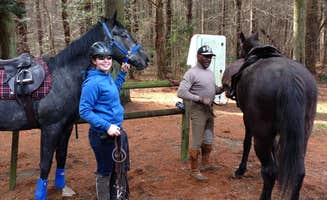The Maryland-Delaware border region offers campers diverse terrain with rolling hills, dense forests, and river access points. Most equestrian camping near Kennedyville, Maryland sits between 50-300 feet above sea level, with mild seasonal temperatures ranging from 30°F in winter to 85°F in summer. Campgrounds in this area typically experience moderate precipitation with annual rainfall averaging 45 inches.
What to do
Trail riding exploration: Nearby Fair Hill Natural Resources Management Area provides extensive horse trails through various terrain types. "There are two primitive youth group camping areas. There are specific rules that need to be followed and the guidelines are on the website," notes camper Gen F.
Water activities: Martinak State Park Campground offers riverside recreation. Laura M. states, "Campsites and bathrooms are clean. Beautiful waterfront great for kayaking and water sports. No real hiking trails. Overall small quiet campground." The park maintains river access points for fishing and small watercraft.
Family recreation: Multiple playgrounds and structured activities await at various campgrounds. "We had a great time with our 3 little ones. They have lots of easily walked trails. Bath houses are kept clean. They have quite a few playgrounds throughout the park, which was a major plus for us," shares Bill F. about Martinak State Park.
Off-season exploration: Many trails remain accessible during cooler months when crowds thin out. Some campgrounds operate year-round, while others close for winter from late November through March. Early spring and late fall provide optimal weather conditions for trail riding.
What campers like
Privacy between sites: Blackbird State Forest Campground offers secluded camping experiences. "Only 8 sites in the campground, very spaced apart. Each site has lots of room, very much enjoyed our stay and will return!" remarks Sarah M. The distance between campsites allows for quieter overnight experiences.
Clean facilities: Tuckahoe State Park Campground maintains well-kept amenities. "The bathroom/showers are the cleanest I've ever seen, especially since we stayed in the hottest time of the year," notes Bill G. Consistent maintenance makes for comfortable extended stays.
River access: Multiple campers praise the direct water entry points. "Spent a weekend in BO1, spacious campsite, grill, picnic table, firepit, parking for 2-3 cars plus overflow parking," writes John C. about Blackbird State Forest. Water proximity adds versatility to camping experiences.
Level sites: Terrain preparation at most campgrounds ensures comfortable parking. "Easy to navigate through with a trailer. Nice trails and playground. Bathrooms were like brand new. Water and electric on our loop," reports Rhonda S. about Martinak State Park.
What you should know
Limited availability: Horse-friendly campsites fill quickly during peak seasons. Reservations are essential, especially for holiday weekends from May through September.
Variable hookups: Lums Pond State Park Campground offers full hookups. "Sites are big and all were redone in the last few years with concrete pads, 30 amp service and full sewer. There are some equestrian and tent sites as well," shares Ellen B. Other campgrounds may offer only electric or primitive sites.
Trail conditions: Seasonal weather affects trail usability for horses. Spring can bring muddy sections, while summer offers drier footing but more bugs. Fall provides optimal trail conditions with cooler temperatures and colorful scenery.
Advance planning required: Some campgrounds don't provide stabling facilities on-site. "Book early because it fills up fast!" advises Ellen B. about Lums Pond State Park. Bring portable containment systems for overnight horse camping.
Shared trails: Most paths accommodate multiple recreational users. "20 miles of hiking trails are also open for biking and horseback riding," notes Mary S. about Tuckahoe State Park.
Tips for camping with families
Playground proximity: When selecting sites, consider distance to play areas. "The camp sites are laid out in a circle with the bathhouse in the center," explains Jessica K. about Tuckahoe State Park, making facility access convenient for younger children.
Educational opportunities: Camp Meade RV Park offers unique experiences. "Was great not to have to really worry about anything because you are securely on post. I forgot all about revielle 🤣. They reminded me," shares Elvin J. Many parks offer junior ranger programs for children.
Child-friendly trails: Select appropriate routes for younger riders. "They have lots of easily walked trails," reports Bill F. about Martinak State Park. Request trail maps at ranger stations to identify suitable paths.
Site selection strategy: Choose sites away from main roads for safety. "The firepit was about 3-4 feet from our door. No camp fires as it was not safe," cautions Buck P. about Tuckahoe State Park, highlighting the importance of evaluating site layouts for family safety.
Tips from RVers
Access considerations: Campground roads vary in quality and width. "We paid $46 per night plus fees for a FHU 50 Amp Back-in site(#56)," shares Matt S. about Lums Pond State Park, which offers well-maintained roads and sites.
Amenities available: "The bathhouse is dated and was clean enough to use. There isn't much to do in the park but it was an ok jumping off point to visit St. Michaels. Good dump station and potable water fill," notes Adam and Suzanne B. about Tuckahoe State Park.
Site size limitations: Some campgrounds have restrictions on larger rigs. "I watched people with 25+ footers struggle to back into the sites," warns Buck P. Check maximum length specifications when booking.
Parking configurations: Site layouts affect convenience. "The site was fairly level, side-to-side, so I really only needed to level front to back," explains Mark about Lums Pond State Park, demonstrating the importance of understanding site grading.


